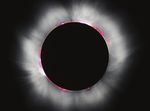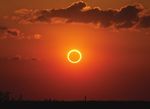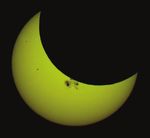The Great American Annular Eclipse of the Sun
←
→
Page content transcription
If your browser does not render page correctly, please read the page content below
The Great American
Annular Eclipse of the Sun
Saturday, October 14, 2023
An Information Sheet by astronomers/educators Dennis Schatz & Andrew Fraknoi
Distributed courtesy of the National Science Teaching Association
On Oct. 14, 2023, there will be a dramatic annular
eclipse visible to people on a narrow path from Ore-
gon going southeast to Texas (see map below). A par-
tial eclipse of the Sun will be visible to everyone in
North and Central America, with a bigger “bite” taken
out of the Sun the closer you are to the path of the
annular eclipse.
In this kind of eclipse, the Moon gets in front of the
Sun, but it is too far away and, therefore, too small
to cover it completely, leaving an annulus (or “ring of
fire”) around the dark disk of the Moon.
We talked about the annular eclipse in class, so your
child should be able to tell you more about what to
Most people in North America will see a partial eclipse.
expect. On the next page is the information for what
Photo by Tomruren
will happen in our location.
Only those people in the narrow path of annularity will
see the annular eclipse.
Photo by Kevin Baird
The path of the annular eclipse. (Credit: Xavier Jubier)
25The Great American Annular Eclipse of the Sun | Saturday, October 14, 2023
Source: SEAL Guide
Hopefully, the skies will be clear and you can get a
great view of this rare astronomical event. There will Observing the Sun Safely
also be a total eclipse visible in U.S. next April (Monday, Because some part of the Sun will be showing
April 8, 2024); information about that will be sent later throughout this eclipse, it will be important to use
in the school year. safe-viewing strategies to protect your eyes. It
You can find out what will happen at other loca- is never safe to look directly at the Sun. Regular
tions by going to: www.timeanddate.com/eclipse sunglasses, swimming goggles, and most camera
/solar/2023-october-14 filters are NOT safe for looking directly at the Sun.
There are many indirect ways to observe the eclipse, You can observe the Sun indirectly using the ideas
so having solar-viewing glasses is not required. Most below. Or, you can safely protect your eyes with
homes already have the perfect pinhole projector certified solar-viewing glasses from your library
to produce multiple images of the partially eclipsed or another reliable institution (such as a local
Sun—a colander. To use it during the eclipse, stand science museum or college/high-school science
with your back to the Sun and hold up a colander so department). Make sure that on the back, in small
that the Sun’s light shines through it on the ground print, they say that they are ISO 12312-2 certified.
or a wall where there will be many tiny images of the
eclipsed Sun in the colander’s shadow.
Another easy method to observe the eclipse is to
take two pieces of cardboard or thick paper. Put a pin-
hole in one (taking care to make a small, neat hole).
Then, stand with your back to the Sun and let the Sun’s
light fall through the hole and onto the other sheet.
You’ll get a small but distinct image of the Sun. (A way
to get a sharper pinhole is to cut a square out of the
middle of one piece of cardboard, tape a sheet of alu-
minum foil over the hole, and put the pinhole in the foil
instead of the cardboard.) The farther apart the two
pieces of cardboard or paper, the larger the image of
the Sun will be (but it will be a small image in any case). NASA Image by Joy Ng
Image source: SEAL Guide, similar image is in Solar Science
26 National Science Teaching AssociationA North American
Total Eclipse of the Sun
Monday, April 8, 2024
An Information Sheet by astronomers/educators Dennis Schatz & Andrew Fraknoi
Distributed courtesy of the National Science Teaching Association
On April 8, 2024, there will be a spectacular total
eclipse of the Sun, visible on a narrow path that
stretches from western Mexico through Texas, and
then northeastward toward New York, New England
and eastern Canada. In such a total eclipse, the Moon
exactly covers the Sun, and our star’s faint atmo-
sphere (the corona) becomes visible. Everyone else in
North and Central America will see a partial eclipse of
the Sun, with a bigger “bite” taken out of the Sun the
closer you are to the path of the total eclipse.
If you are on the path, when only a sliver of sun-
light remains visible, your surroundings will begin to
darken, as if the Sun were setting in the middle of
the day. Temperatures will drop and birds will go to Most people in North America will see a partial eclipse.
roost, thinking that night is coming. Finally, the Sun Photo by Tomruren
will be totally covered and the beautiful solar atmo-
sphere (the corona) will become visible. Totality will
last four minutes or less and then the Sun will slowly
be uncovered.
Only those people in the narrow path of totality will
see the total eclipse.
Photo by Luc Viatour
The path of the total eclipse. (Credit: Xavier Jubier)
27A North American Total Eclipse of the Sun | Monday, April 8, 2024 Source: SEAL Guide We talked about the total eclipse in class, so your child should be able to tell you more about what to Observing the Sun Safely expect. At the top of this page is information for what Because some part of the Sun will be showing during will happen in your location. Hopefully, the skies will be most of this eclipse, it will be important to use safe- clear and you can get a great view of this rare astro- viewing strategies to protect your eyes. It is never nomical event. There will not be another total eclipse safe to look directly at the Sun, except during the brief visible in the continental U.S. until 2045. period of totality, when you can only see the faint You can find out what will happen at other loca- solar corona by looking directly at the eclipsed Sun. tions by going to: www.timeanddate.com/eclipse Regular sunglasses, swimming goggles, and most /solar/2024-april-8 camera filters are NOT safe for looking directly at the There are many indirect ways to observe the eclipse, Sun. You can observe the Sun indirectly using the so having solar-viewing glasses is not required. Most suggestions below. Or you can safely protect your eyes homes already have the perfect pinhole projector with certified solar-viewing glasses from your library to produce multiple images of the partially eclipsed or another reliable institution (such as a local science Sun—a colander. To use it during the eclipse, stand museum or college/high-school science department). with your back to the Sun and hold up a colander so Make sure that on the back, in small print, they say that that the Sun’s light shines through it on the ground they are ISO 12312-2 certified. or a wall where there will be many tiny images of the eclipsed Sun in the Colander’s shadow. Another easy method to observe the eclipse is to take two pieces of cardboard or thick paper. Put a pin- hole in one (taking care to make a small, neat hole). Then, stand with your back to the Sun and let the Sun’s light fall through the hole and onto the other sheet. You’ll get a small but distinct image of the Sun. (A way to get a sharper pinhole is to cut a square out of the middle of one piece of cardboard, tape a sheet of alu- minum foil over the hole, and put the pinhole in the foil instead of the cardboard.) The farther apart the two pieces of cardboard or paper, the larger the image of the Sun will be (but it will be a small image in any case). NASA Image by Joy Ng Image source: SEAL Guide, similar image is in Solar Science 28 National Science Teaching Association
You can also read

























































